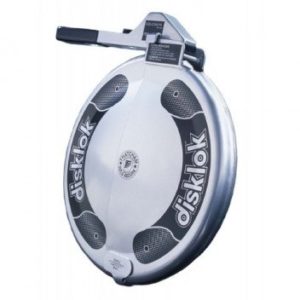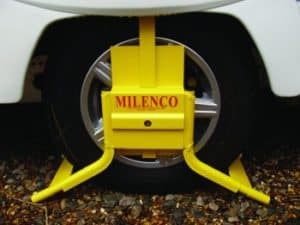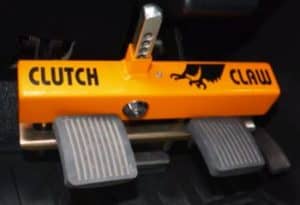Our motorhomes are precious to us as owners and the last thing we want to see is it disappearing into the distance with a thief at the wheel. Security is the key to your motorhome, with the aim of keeping out the most determined thief.
What is the Best Security for a Motorhome or Campervan? There are a variety of things you can do to secure your van and reduce the likelihood of theft. From wheel clamps to alarms, to steering locks and clutch claws.
How can I stop my motorhome from being stolen? There isn’t such a thing as 100% protection, but by taking a range of security measures, you can reduce the chances of theft significantly. Some of the ideas here are very visible and act as an immediate deterrent, others are more subtle. Using more than one security option is always advisable. Let’s dive in.
Security vs Insurance for Motorhomes
Although you won’t want your van stolen, it will be insured so you will be paid by your insurance company. Or will you?
When did you last check your insurance policy documents for the infamous small print? I was talking with another motorhome owner recently, who decided to read his renewal paperwork carefully.
He discovered a new clause added by his insurer at his last renewal, which said that theft was now only covered if the security measures specified were fitted AND in use. Had he not checked the wording and if his motorhome had been stolen, his insurance may have been invalid, and he would have received nothing.
The moral here is, if you have security measures, make sure they are being used effectively, especially if they are an insurance company requirement.
How Do I Prove the Security Measures Were in Place?
Difficult one that. One solution would be to take some pictures of the security measures on your motorhome when they are in place. If your insurer asked for proof, you can submit the photographs showing what you do each time.
OK, so the photographs won’t be immediately before any theft, but they may help you in case of a claim.
15 Motorhome Security Measures
1. Steering Wheel Lock
2. External Wheel Clamp
3. Clutch Lock
4. Alarm
5. Tracker
6. Engine Immobiliser
7. Registration Number on Roof
8. Post in Driveway
9. Window Locks
10. Garage, Lockers & Door Locks
11. Bicycle Locks
12. Safe
13. Security Camera
14. Ladder Security
15. Registration number etched on windows
Let’s look at each one in turn.
Steering Wheel Locks
 This is one of the most visible security deterrents and very easy to use. They will stop the casual thief as they will need time to attempt removal.
This is one of the most visible security deterrents and very easy to use. They will stop the casual thief as they will need time to attempt removal.
Whenever I park my motorhome, the steering lock is applied immediately. This includes a ten minutes trip to the supermarket, as well as always at home and at and campsites. The only time I don’t use the steering lock is when paying for diesel. And then I have locked the door and have the keys in my pocket.
There are several styles available. One of the most popular is made by Disklok. These cover the entire steering wheel and effectively spin when anyone tries to turn the wheel. They come in various sizes depending on the diameter of your steering wheel and are different for left or right-handed drive motorhomes.
A second visible deterrent is the bar style, often known by the brand Crooklock. These fit through the spokes of the steering wheel and are locked by a key or combination lock. They take moments to fit and remove. A vehicle can still be driven to some extent when one of these is in place, but the arm of the lock should prevent much movement, and turning corners is pretty much impossible. More Steering Locks.
Motorhome Wheel Clamps
 Motorhome wheel clamps are another visible deterrent and are fitted to one of the wheels of the van. They look much like a parking clamp and that is exactly what they are.
Motorhome wheel clamps are another visible deterrent and are fitted to one of the wheels of the van. They look much like a parking clamp and that is exactly what they are.
There are a couple of different types. The first is made by Milenco and is like the parking clamp you might find if you overstay your welcome on a yellow line. Fitted to the front wheel on the driver’s side, any thief who wants to break in is going to see the clamp.
These clamps take a short while to fit and remove but are ideal when you are on a campsite and especially on the driveway at home. They would be essential if your motorhome is kept in rented storage.
A less expensive option is also made by Milenco. This fits a bar through the wheel and locks to itself. Faster to fit than the larger full clamp, again, these are for use when you are stopped for more than just a few minutes. Again, fit this to the driver’s front wheel as a visible and physical deterrent. A selection of wheel clamps.
Clutch Claw
 These are a clever device which fit over the clutch or other pedals on your motorhome.
These are a clever device which fit over the clutch or other pedals on your motorhome.
They make it impossible to drive the motorhome at all, as the pedals can’t be used.
The Clutch Claw does take a little setting up the first time, to adjust it to your specific pedal configuration and distances to the floor. Once set, it doesn’t take too long to fit each time you need. It locks the pedals completely and there is no movement possible.
Models such as the Centinal Security Clutch Claw take a few minutes to fit, so you will generally use them at a campsite or at home, rather than on a quick visit to Sainsbury. More on the clutch claw.
Alarms for Motorhomes
Your motorhome may already be fitted with an alarm. They can also be fitted retrospectively.
Depending on the model, they can be activated when a door is opened, or when any movement of the motorhome is detected. The main deterrent here is that when an alarm sounds, the chances are that the potential thief will leg it.
You may find that depending on the value of your motorhome and your insurance company, the use of an alarm is required for your van to be covered for theft.
Trackers for Motorhomes
Trackers are another item that may be mandated by your insurance company. It was worth checking your policy documents if you are unsure.
There are a variety of trackers on the market in different styles and grades. Some you can fit yourself, other your insurance company will depend are fitted by a recognised professional fitter.
Some trackers are self-contained and with a SIM fitted will notify you. Others require a subscription, which advised both you and the tracking company of a theft.
If a vehicle is stolen, the tracker will activate and send you a notification. You should be able to see where the vehicle is located at any moment.
Immobilisers for Motorhomes
Most motorhomes based on commercial vehicles will have an immobiliser fitted when the engine was first built. Again, you may find this is a requirement for theft insurance.
The theory is that without the right key, the engine may turn over, but it won’t start.
Insurers may specify that the immobiliser meets a certain standard, which could mean you will need to change the existing one fitted.
Registration Number on Roof
Some owners think this is a good idea, others say it is a waste of time.
For instance, if your vehicle is stolen, the police are unlikely to scramble the nearest helicopter to try and find it.
However, when a vehicle is stolen, the first thing a thief will do is to change the number plate. This may be as simple as sticking fake plates over the existing ones which take just moments.
With your number plate letter and numbers on the roof, a thief is less likely to attempt a theft, as those are not easily removed. Although, how would the thief know without climbing up and taking a look?
If you have personal registration plates, this may not be a good idea, as removing them when you sell the van can be tricky and is likely to leave marks.
Driveway Security Post
The more deterrents you put in the way of the thief, the better.
If you keep your motorhome outside in the driveway, it is very visible. A potential thief can size up the likely security measures ahead of coming back one night and driving your precious van away never to be even again.
A visible security measure is to add a post immediately in front of the van. These either fold down when unlocked or lift out of the ground. Using the post close to the van, if someone does manage to start the engine, they won’t be able to knock it down easily, unless they can build some momentum first.
Window Locks
These are easy and inexpensive security solutions.
They fit over the existing window locks, preventing them from being easily accessed and opened from the outside by a thief. They can be removed in a moment from inside when you want to open the window.
If a thief breaks the window completely, they offer little additional protection.
Locker, Garage and Habitation Door Security
These are vulnerable areas on any motorhome.
Some thieves are not after the whole van, but just want to raid the contents. Levering open a side habitation door is easy and the same goes for the average garage door or locker.
One solution here is to fit special additional locks to each door and locker. The exact product you will need is going to depend on the make and model of your motorhome, so finding the right combination will take a little research.
Bike Security on the Back of a Motorhome
Many motorhome owners have a bike rack fitted to the back of the van. It is so good to be able to park at a campsite and then cycle to the nearest town or to explore the countryside.
The problem comes, when the bikes are mounted on the motorhomes bike rack and you are asleep or away for a time.
Cycle locks are the obvious first solution, locking bikes to the rack. A cover for the bikes, securely tied down will both protect the bikes from the elements but add to the time a thief needs to steal them. When covered, the thief doesn’t know what they may face as your next level of security and the cover may be enough for them to walk on by.
Motorhome Safe
Passports, wads of cash, a diamond tiara, all common needs for the average motorhome owner.
These can all be locked away in a small safe inside the motorhome. Where and how you mount a safe will depend on the motorhome design and availability of space. When deciding what to do here, consider whether a thief can simply lift it out and open it later.
The existence of a safe indicates to a thief that there is something worth stealing, so ask whether it is a good idea to have one at all. Also, consider the weight of a safe and fittings, and how that may affect your total payload.
In the days of debit or credit cards which can be used at zero fees when traveling in the UK or Europe, many will today question carrying more than a few notes of currency at all.
And anyway, you can always leave the diamond tiara at home!
Security Camera at Home
This is one for home rather than for the van itself.
A simple CCTV camera on the side of our home linked to a recording device may register someone stealing your van or attempting to do so. The police can make use of the recording and may be able to use their facial recognition software to identify the thief.
The visibility of a CCTV security camera may be enough to deter a thief from trying to break in. Some people fit a fake camera to save money, but a thief will often be able to spot a fake. Your option.
Ladder Security
More modern motorhomes don’t tend to have a ladder, but many older ones have one fitted.
While still easy to climb, if they are folded up and locked, it makes it a little more difficult. Someone on your roof could break in through a skylight or steal your expensive motorised satellite dish. Make it that little more difficult by locking the ladder.
Also, if unlocked, it could fall open while you are driving, so this is also a safety matter.
Registration Number Etched on Windows
This is a classic. Any thief worth their salt is going to check whether the driver and passenger window has the registration etched on them. If they intend to put fake plates on a motorhome, that is easy. Changing or replacing the windows is another matter.
How Many Security Measures Should I Choose for my Motorhome?
This will depend on your level of worry and on what your insurance company may require.
A mixture of visible security measures (steeling lock, external wheel lock) and unseen options (immobiliser, tracker, alarm) is best.
Whatever option you choose, do more than one. I remember on the TV version of Sherlock Holmes, that the main character when asked about what people look for, said that generally, people stop looking after three, as they think everything is found by then.
Stay safe!
